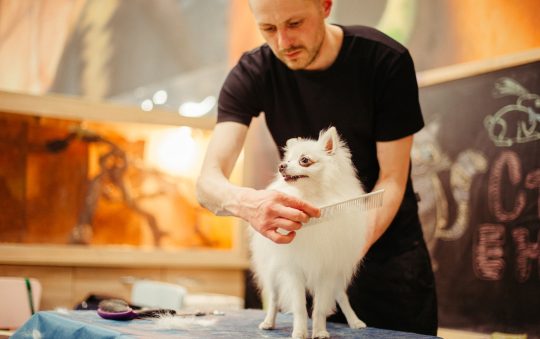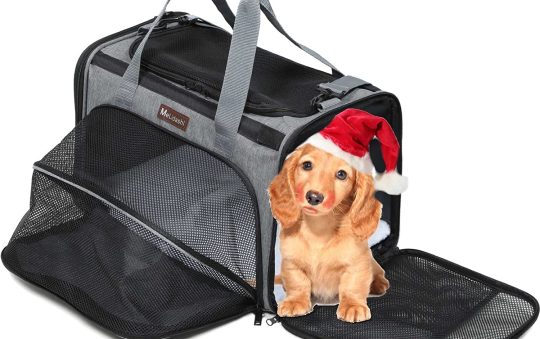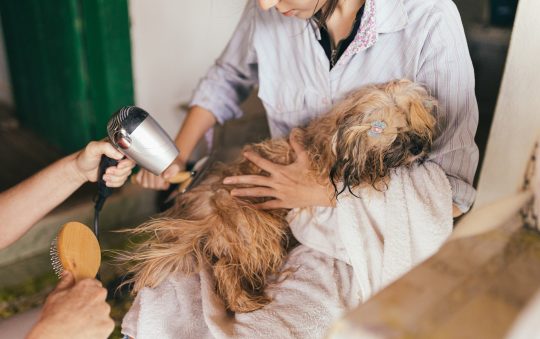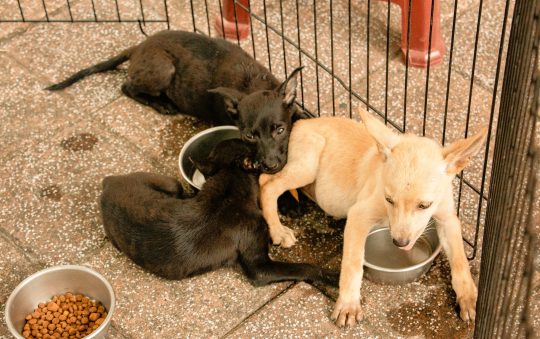The Importance of Puppy Training
Are you a new puppy owner struggling to train your furry friend? Don’t worry, you’re not alone. Many pet owners find themselves overwhelmed by the responsibility of training their puppies. But fear not, because with a little patience, consistency, and positive reinforcement, you can establish a strong bond with your puppy while also teaching them essential skills that will set them up for a lifetime of success.
In this article, we’ll cover the basics of puppy training, including housebreaking, crate training, basic commands, socializing, nutrition, and exercise. We’ll provide tips and tricks for each section, as well as common problems and how to solve them. Whether you’re a first-time puppy owner or just need a refresher course, this guide will help you navigate the often-confusing world of puppy training.
Training your puppy is crucial for their development into a well-behaved dog. Not only will it make your life easier as a pet owner, but it will also ensure your dog’s safety and happiness. By teaching your puppy basic commands such as sit, stay, come, down, leave it, and heel, you’ll be able to communicate effectively with them and prevent dangerous situations from arising. Housebreaking and crate training will also provide comfort and security for your puppy while preventing accidents in the home.
But training isn’t just about obedience and safety. It’s also a great way to establish a strong bond between you and your furry friend. By using positive reinforcement techniques and spending time with your puppy each day, you’ll build trust and affection that will last a lifetime.
So whether you’re ready to start housebreaking your puppy or just looking for tips on how to improve their nutrition and exercise routine, we’ve got you covered. Let’s get started on the journey to a happy and well-trained pup!
Housebreaking Your Puppy
Housebreaking your puppy is one of the most important parts of training, as it lays the foundation for a healthy, safe, and stress-free lifestyle between you and your pup. It teaches them vital potty training skills and can prevent a lot of unwanted behavior in the future. So what exactly is housebreaking your puppy, why is it so important, and when should you begin?
Housebreaking is the process of teaching your puppy to pee and poop outside instead of indoors. This helps to keep your home clean and free of odor and messes. It also helps to keep your pup safe by preventing them from coming into contact with dangerous substances. Housebreaking is important because it establishes good habits early on that will stay with your dog for life. It also helps to build trust and respect between you and your pup, as they learn to follow your instructions.
When it comes to housebreaking your puppy, establishing a routine is key. You should start potty training when your pup is about 12 weeks old, keeping in mind that puppies need to use the restroom more often than adult dogs. Start by taking them out every few hours or after meals, playtime, or naps. When they do their business outside, be sure to reward them with verbal praise or treats – this will create a positive association that will encourage them in the future.
Common housebreaking problems include accidents inside the house, crate training issues, and inconsistency in their routine. To solve these issues, you should use crate training to help your pup understand when and where they should go. When they are confined in a crate while you’re away, it helps limit the amount of space they have access to, making accidents less likely. You should also keep in mind that consistency is key – try not to change up the times you take them out or the cues you use too much.
By following these tips and being patient with your pup, you’ll be able to successfully housebreak them in no time! Establishing routines, using positive reinforcement techniques, and managing mistakes will all help ensure that your pup grows into a happy and well-behaved dog.
Crate Training Your Puppy
Crate training your puppy can benefit them in numerous ways, offering safety, security and comfort. This form of training is a great way to make sure your pup is safe and secure when you’re away. Here are some tips and tricks to help you crate train your puppy successfully.
The first step to crate training your pup is creating a positive association with the crate. Make it a comfortable place for your pup by adding a soft blanket, treats, and toys. You should also make sure the crate isn’t too large – it should be just big enough for the pup to stand up, turn around and lay down in comfortably.
Once your pup is comfortable with their crate, you can begin working on establishing a routine. Start slow, leaving them in their crate for short periods of time and gradually increasing the duration over time. To help keep your pup from getting anxious or bored while in their crate, give them treats while they’re inside. For example, give them a treat when they enter the crate, as well as when they come out. Positive reinforcement is key!
Lastly, be aware of common mistakes people make while crate training their pups. Never scold or punish your pup if they have an accident in their crate – this will only create a negative association with their crate and make it more difficult to train them properly. Instead, focus on reinforcing positive behavior whenever they use their crate correctly. Finally, don’t leave your pup in their crate for too long – puppies need time outside of the crate to explore and socialize with other animals and humans.
Crate training your puppy can be a rewarding experience for both you and your pup if done correctly. By introducing your pup to their crate in a positive way and establishing a regular routine, you can ensure successful crate training with minimal stress!
Teaching Basic Commands to Your Puppy
Teaching basic commands to your puppy is essential for its development and safety, and serves as an effective method of communication between you and your pup. By giving your puppy clear instructions, they will learn the boundaries of acceptable behavior, ensuring they are a well-behaved, safe, and obedient member of the family. When training your puppy, it is important to use positive reinforcement techniques such as treats, verbal praise, and scratches behind the ears.
The most important commands to teach your puppy are sit, stay, come, down, leave it, and heel. Teaching them to sit is a fundamental command that helps establish control and order in a situation. Stay teaches your puppy patience in waiting for further instruction or permission before taking action. Come teaches them to obey and return when called. Down teaches them to lay down in any situation when instructed. Leave it teaches them to avoid food or objects that may be dangerous. Lastly, heel teaches them to walk with you without getting distracted.
To ensure successful command training, it is important to break down each command into simple steps, using positive reinforcement for correct behaviors. Start with simple commands such as sit or come with no distractions and move on from there. Once your puppy has mastered this command in one environment with no distractions, then you can start introducing more complexity with added distractions. It is important to show your puppy lots of patience and consistency when teaching basic commands; this will help create a strong bond between you and your pup.
In addition to verbal commands, hand signals can also be used to teach basic commands such as sit or stay. Hand signals are a great way to give your pet alternative communication cues so they can better understand your instructions. If your puppy has difficulty understanding verbal commands, you can use hand signals as a visual cue instead.
By teaching your puppy basic commands such as sit, stay, come, down, leave it, and heel you can ensure their safety and obedience as they grow into an adult dog. Using positive reinforcement techniques such as treats and verbal praise will help create a strong bond between you and your pup while establishing clear boundaries for good behavior that will last a lifetime.
Socializing Your Puppy
Socializing your puppy is an important part of their training, as it helps them to become well-adjusted and confident. Socializing helps to prevent fear-based and aggression-based behaviors in the future, as your puppy learns how to interact appropriately with other animals, people, and environments. To ensure that your puppy has a good start in life, it’s important to expose them to different situations from an early age.
When socializing your puppy, you want to make sure that they are having positive experiences. Start by introducing them to different people, including both adults and children. Ask others to pet them and give them treats (if safe). This will help your puppy learn to trust people and enjoy being around them. You can also take your puppy on outings, such as walks or trips to the park, so that they can get used to different sights, sounds, and smells.
It’s also important to introduce your puppy to other animals. Start off with animals that are friendly and non-threatening (such as a cat), then gradually introduce them to other puppies or dogs. Make sure that you’re watching the interactions closely and looking out for any signs of fear or aggression. If either of these behaviors are present, you should stop the interaction immediately and work on desensitizing your puppy using positive reinforcement methods.
Common socialization problems include fearfulness, shyness, and aggression. If you notice any of these behaviors in your puppy, you should take steps to address the issue immediately. Fearful behavior can be addressed by exposing your pup to new situations in a slow and controlled manner and rewarding them with treats for calm behavior. Shyness can be managed by building up their confidence through positive reinforcement techniques such as praising them for good behavior and providing lots of opportunities for reward-based learning. Aggression can be addressed by teaching your pup basic commands such as “leave it” or “sit” and rewarding them whenever they obey these commands.
Socializing your puppy is a crucial part of their training. It helps to prevent fear-based and aggression-based behaviors in the future while teaching your pup how to interact appropriately with different people, animals, and environments. Make sure that you start socializing your puppy at an early age by introducing them to different people, animals, and environments in a slow and controlled manner and rewarding them with treats for good behavior. If fearfulness, shyness, or aggression occur during these interactions, take steps to address the issue right away using positive reinforcement techniques.
Nutrition and Exercise for Your Puppy
Nutrition and exercise are essential elements of a puppy’s holistic development. From their growth to their behavior, they play a fundamental role in the way your pup develops into a healthy and happy dog. Proper nutrition is essential for your pup’s growth, development, and overall health, while exercise is essential for mental stimulation and physical wellbeing.
If you want to ensure that your puppy is growing up healthy and strong, it’s important to understand the basics of nutrition and exercise. This includes knowing what types of food to feed them, when to feed them, and how much to feed them; as well as what types of exercise they should be getting, how much they should be getting, and when they should be getting it.
When it comes to nutrition and exercise, the key is to start early. Starting with good nutrition and exercise habits will ensure your pup has the best chance for a healthy life. It’s important to talk to your vet about your puppy’s nutritional needs, as well as appropriate types of exercise for their age, breed, size, and health condition.
When it comes to nutrition, choosing the right food is essential for your pup’s health. Make sure to read labels carefully; look for high-quality ingredients that are appropriate for their age and size. Variety is also important; offering a variety of nutritious foods can help keep your pup’s diet interesting and provide them with the necessary nutrients they need. Additionally, establishing a feeding routine can help create consistency in their diet and make it easier to monitor their intake. It’s also important to pay attention to portion sizes; puppies need more frequent meals but in smaller amounts than adult dogs.
Exercise is just as important as nutrition when it comes to keeping your pup healthy. Make sure that they’re getting enough physical activity based on their age and size – this could be anything from walks to interactive games like fetch or tug-of-war. Exercise not only helps maintain their physical health but also provides mental stimulation that can help keep them from getting bored or destructive. Keep in mind that young puppies shouldn’t engage in too much strenuous activity – walking or light play is usually sufficient for puppies under five months old.
Nutrition and exercise are very important for puppies – both physically and mentally – so it’s important to start good habits early. By providing your pup with a balanced diet and plenty of physical activity, you can ensure that they grow up happy and healthy.
Wrapping Up Puppy Training Basics
In conclusion, Making the Right Choice for Your Next Ice Fishing Adventure
Choosing the right ice fishing rod can make all the difference in your experience on the ice. By considering factors such as length, power, action, and materials, you can find a rod that suits your needs and budget. Whether you’re a beginner or an experienced angler, there’s a rod out there that’s perfect for you.
It’s important to keep in mind the type of fishing you’ll be doing and the type of fish you’ll be targeting. Consider your budget and look for a rod that offers good value for your money. Don’t be afraid to experiment and try out different rods to find the one that best suits your needs.
At the end of the day, choosing the right ice fishing rod is all about finding the one that feels comfortable and natural in your hands. With the right rod, you’ll be able to feel every bite and set the hook with ease. So take your time to find the perfect rod for your next ice fishing adventure, and get ready to enjoy a fun and successful day on the ice.
In summary, Wrapping Up Puppy Training Basics
Congratulations on taking the first step towards raising a well-behaved and happy puppy! By following the tips and techniques outlined in this guide, you can establish a strong bond with your furry friend while teaching them essential skills like housebreaking, crate training, basic commands, socializing, nutrition, and exercise.
Remember that training is an ongoing process that requires patience, consistency, and positive reinforcement. Don’t get discouraged if progress seems slow at times – with dedication and effort, you’ll see results over time.
Above all, enjoy the journey of puppyhood with your new companion. Training will not only help them become a wonderful addition to your family but also strengthen the bond between you both. Happy training!






